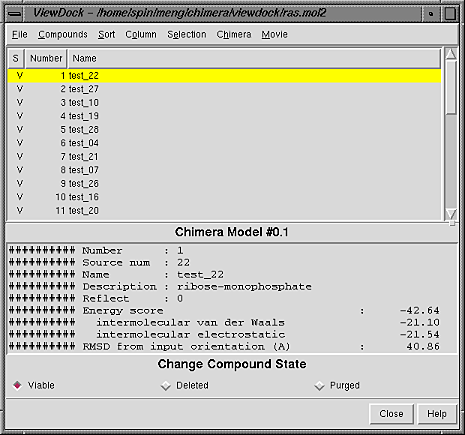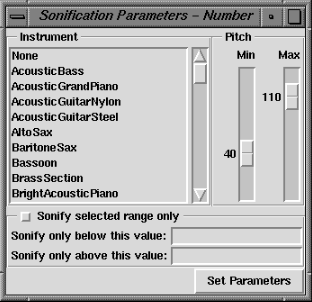 and HearDock
and HearDock 
 and HearDock
and HearDock 
The program DOCK calculates possible binding orientations, given the structures of ligand and receptor molecules. The structure of a physiologically important target molecule can be used to find other molecules that may bind it and modulate (usually inhibit) its function. Generally, one searches a large database of commercially available compounds with DOCK, treating each as a possible "ligand," against the structure of a target protein, treated as the "receptor." Simple scoring methods are used to identify the most favorable binding modes of a given molecule, and then to rank the molecules according to these best orientations. The output consists of a large number of candidate ligands in the binding orientations considered most favorable by DOCK. It is then up to human users to look through the molecules and decide which ones are worth pursuing in the real world. It is beyond the scope of this manual to describe DOCK in further detail; please consult the DOCK web page and other information from the program's creators (Kuntz and coworkers).
ViewDock facilitates the selection of compounds by a human user from the output of DOCK (versions 3, 4 and the Northwestern University variant, "NUDock"). For a less formal explanation, see the ViewDock tutorial. With a single mouseclick, the user can view an individual docked molecule and simultaneously display its name, DOCK scores, and other information. The list of molecules can be sorted in various ways, edited to remove compounds deemed uninteresting, and saved for future reference. HearDock includes the functionality of ViewDock, but also allows sounds to be associated with properties such as score.
There are several ways to start ViewDock (or HearDock), a tool in the Docking category. Starting ViewDock (or HearDock) brings up a dialog requesting the file of molecule orientations previously output by DOCK. When the file containing the docked molecules has been read, the ViewDock ListBox will appear and all of the molecules will be displayed in the main Chimera window. ListBox menu items are explained within the following sections, and a full menu listing with short descriptions is included at the end of this page.
Most users will want to view the molecules individually in the context of the receptor site, and thus will open the structure of the receptor molecule, display and color the portions of interest, and change representations or include surfaces as desired. Coloring atoms by type may also be helpful. Once the appropriate viewing context has been set up, individual docked molecules can be examined using the graphics window and ListBox.
| ViewDock ListBox |
|---|
 |
At first, all of the lines in the upper panel of the box are highlighted and the lower panel is blank. The upper panel shows molecule status (S) and various descriptors; which descriptors are shown depends on the input format and customization by the user.
A compound can be chosen by clicking on its line in the top panel. Multiple compounds may be chosen at once. Chosen lines are highlighted and only the structures of the chosen compound(s) are displayed. Ctrl-click adds to an existing choice rather than replacing it. To highlight a block of compounds without having to hold down the mouse button, click on the first (or last) and then Shift-click on the last (or first) in the desired block. In the case of DOCK 4 format, the lower panel shows detailed information when a single compound is chosen.
Descriptors can be included in or removed from the listing in the upper panel using the Column menu. The listing can be sorted by any one of the descriptors using the Sort menu, or if the descriptor is included in the top panel listing, by clicking the column header. Clicking the header once sorts the entries in increasing order of the value in that column and places an up arrow in the header. Clicking again sorts the entries in decreasing order and places a down arrow in the header.
Help brings up this manual page in a browser window; Close dismisses the ListBox. If the ListBox is closed accidentally or becomes obscured by other windows, it can be resurrected using the Raise option for the ViewDock instance in the Tools menu. The instance's Quit option has the same effect as File... Exit.
The user can click through and edit the list of compounds. Three mutually exclusive states are possible for each compound: Viable, Deleted, or Purged. The initial state is viable, but if the molecule is deemed uninteresting, it can be changed to deleted or purged by clicking on the checkboxes near the bottom of the ListBox. Clicking a status checkbox changes the status of all chosen compounds.
In general, Viable compounds are interesting (or have not been looked at yet), Deleted compounds are less interesting but may deserve another look, and Purged compounds are meant to be discarded. When structures are written out using File... Rewrite, viable and deleted but not purged structures are included in the output file. In contrast, structures in all three states are included in a file written out using File... Save or File... Save As. The states of the molecules are also recorded in these output files, which can be input to later sessions of ViewDock (or HearDock). The Compounds menu controls which compounds are listed in the upper panel.
There are other ways to change status besides clicking a status checkbox. If Selection... Prune is activated and part of a compound is picked in the graphics window, the compound is undisplayed and marked as deleted. Chimera... Hydrogen Bonds uses hydrogen bonding information computed by FindHBond to filter the compounds and change their status based on number of hydrogen bonds to the receptor or a selected portion of the the receptor. Additional tips for filtering by H-bonds:
Compounds can be chosen based on the values of any (or all) of the descriptors that can be shown in the ListBox. Compounds... Choose by Value... brings up a dialog for defining value ranges. Whichever descriptors are shown in the ListBox are available for choosing compounds. To add a descriptor to the Choose by Value dialog, simply show the descriptor in the ListBox using the Column menu. Any descriptor shown in the ListBox but not of interest for choosing compounds can be disregarded by unchecking the corresponding checkbox.
Checkboxes under Choose from designate which compounds should be considered, on the basis of their status. The values displayed in the histograms and/or lists only come from this designated set of compounds.
Numerical descriptors are depicted in a histogram. Within a histogram, two markers are shown as vertical bars. Clicking on a marker shows its Value in black. Clicking elsewhere within the histogram shows the Value (X-coordinate) of the mouseclick in gray. A marker can be moved by changing its Value and then pressing Enter (return) or by dragging it horizontally with the left mouse button. Holding the Shift key down reduces the speed (mouse sensitivity) of marker dragging tenfold, allowing finer control. Only compounds with values between the markers (inclusive) will be chosen.
String-valued descriptors are displayed as a list. Clicking a line highlights just that line; Ctrl-click adds to an existing choice rather than replacing it. To highlight a block of lines without having to hold down the mouse button, click on the first (or last) and then Shift-click on the last (or first) in the desired block. Only compounds with highlighted values will be chosen.
A message of the form N of M compounds applicable reports how many of the compounds (N) of those designated to choose from (M) meet all current criteria. These compounds will be chosen when Apply or OK (which also dismisses the dialog) is pressed.
Individual compounds are submodels of a single model (model 0, for example) and are specified #0.1, #0.2, etc. (see atom specification syntax). Even though they are termed submodels, the display of each compound can be independently disabled or enabled at the model level (see display hierarchy). Within ViewDock, there are two ways to control model-level display:
For example, if only the first five compounds are display-enabled,
Command: ~disp #0.2will work. In contrast, other commands like
and
Command: disp #0.2
but not
Command: disp #0.8
Command: label #0.7are executed, although their effects may not be visible until the corresponding molecules are displayed. The command
and
Command: color pink #0.6
Command: disp #0will display only the compounds whose display is enabled at the model level.

Note that DOCK 4 interprets information about each molecule as Name or Description based on where this information occurs in the input database file. Here are examples of a single molecule from (A) a Mol2 database file input to DOCK 4, (B) a Mol2 output file from DOCK 4, and (C) a PDB output file from DOCK 4. Multiple-molecule files are simply concatenations of the data for single molecules. Number is sequential number in order of occurrence in the file from DOCK, and Source num is the sequential number in order of occurrence in the database file input to DOCK.